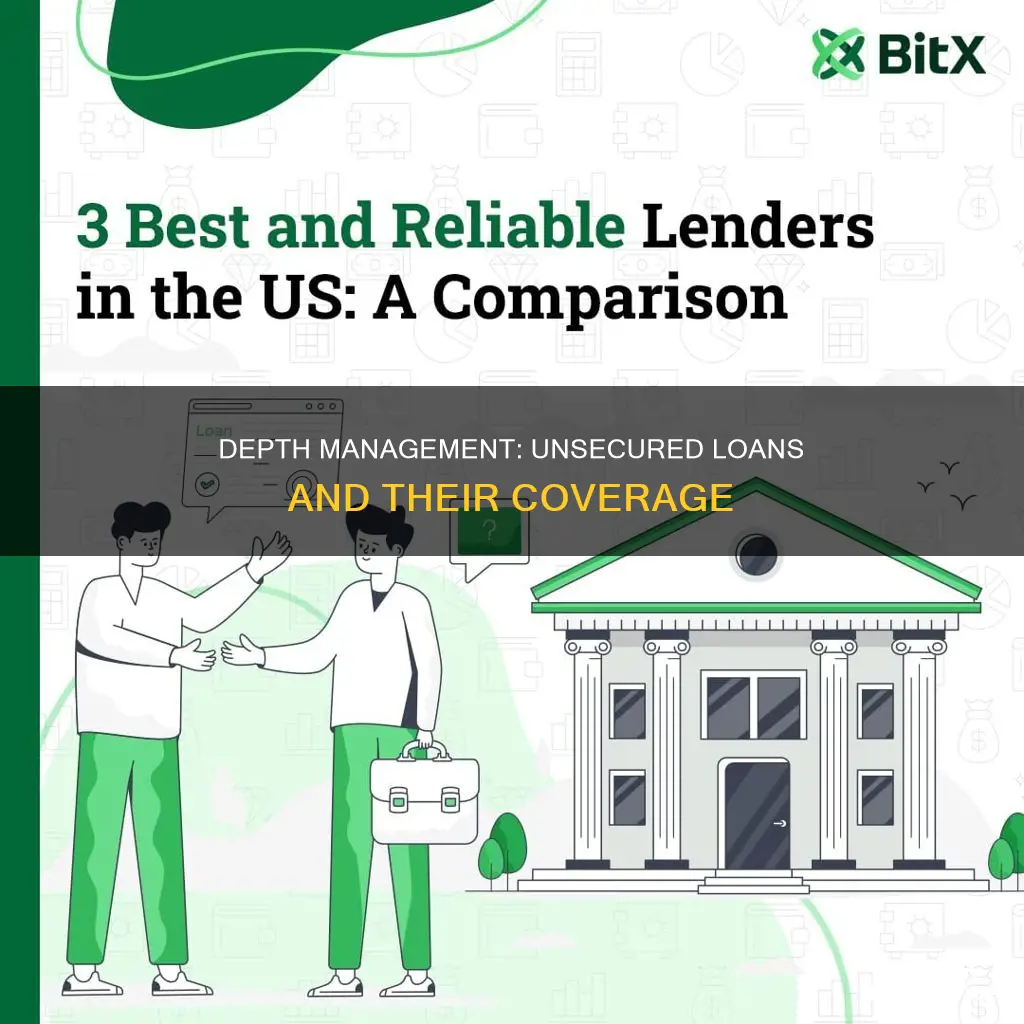
Debt management plans are overseen by credit counselling agencies, which negotiate with creditors on behalf of debtors to create new payment plans. These plans typically involve repaying debts within three to five years. While debt management plans usually cover unsecured debts, such as credit cards and unsecured loans, they may not cover all types of unsecured loans. For instance, student loans are generally excluded from debt management plans. Unsecured debts are loans that are not backed by collateral, such as a borrower's assets, and are therefore riskier for lenders, often resulting in higher interest rates.
| Characteristics | Values |
|---|---|
| What is an unsecured loan? | A loan that is not backed by collateral. |
| What is collateral? | An asset, such as a car, house or cash deposit, from the borrower that backs up the debt. |
| What are the pros of an unsecured loan? | No risk of losing an asset. |
| What are the cons of an unsecured loan? | Higher interest rates, harder to qualify for, and consequences for not repaying. |
| What are the common types of unsecured loans? | Credit cards, student loans, personal loans, medical bills, and utility bills. |
| What is a debt management plan? | A plan overseen by a credit counseling agency, which negotiates with creditors on your behalf to create new payment plans. |
| Do debt management plans cover unsecured loans? | Yes, debt management plans are generally only available for unsecured accounts, or those that aren't backed by collateral. However, they do not cover some types of unsecured loans, such as student loans. |
What You'll Learn

Unsecured loans and credit scores
Unsecured loans are debt products that do not require collateral. However, they often come with higher interest rates and stricter credit requirements. Lenders consider borrowers with unsecured loans to be more of a risk, so they will often require good or excellent credit scores for approval. A high credit score will unlock more favourable terms and interest rates.
When determining eligibility for an unsecured loan, lenders will consider factors such as credit history, income, and debt-to-income ratio. They will also check your credit score, which is calculated based on information in your credit reports. A history of responsible credit use, on-time payments, low credit card balances, and a mix of account types are all positive indicators. Consumers with FICO credit scores of around 700 or higher usually qualify for the best interest rates.
Some payday lenders will advertise unsecured loans with guaranteed approval, but these often come with short terms and incredibly high interest rates. It is best to avoid unsecured loans with no credit check or guaranteed approval. Instead, it is recommended to shop around to find the best deal. Many lenders allow you to pre-qualify for an unsecured loan, so you can see your rates without having to go through a hard credit pull that would impact your credit score.
A debt management plan (DMP) can help you get a new payment plan on your debts, and it can be a practical solution for borrowers struggling with unaffordable debt payments. DMPs are generally only available on unsecured accounts, or those that aren't backed by collateral, such as credit cards and unsecured loans.
Loan Deferral: Resetting Statute of Limitations?
You may want to see also

Unsecured loans and bankruptcy
Unsecured loans are those that are not backed by collateral. This means that the borrower does not put up any assets, such as real estate or a vehicle, to secure the loan. Credit cards, student loans, and personal loans are common types of unsecured debt. Because unsecured loans are riskier for lenders, they typically have higher interest rates and more stringent qualifications for borrowing.
When it comes to bankruptcy, unsecured debts are treated differently than secured debts. In a Chapter 7 bankruptcy, unsecured debts may be wiped clean, but in a Chapter 13 bankruptcy, the debtor must repay all or a portion of the unsecured debts over a three-to-five-year period. It's important to note that certain types of unsecured debt, such as debt incurred from fraud, cannot be discharged in a Chapter 7 bankruptcy.
If you're considering filing for bankruptcy, it's crucial to understand the differences between Chapter 7 and Chapter 13. Chapter 7 bankruptcy, also known as "liquidation bankruptcy," involves the cancellation of most or all debts, and the bankruptcy trustee may liquidate or sell the debtor's property to repay creditors. On the other hand, Chapter 13 bankruptcy, or "reorganization bankruptcy," allows the debtor to retain their assets and create a court-mandated repayment plan.
After bankruptcy, your credit may be severely damaged, and you may find it challenging to obtain new loans. However, it is still possible to get a personal loan after bankruptcy, but you may face higher interest rates and stricter eligibility requirements. To improve your chances of loan approval, focus on repairing your credit, prequalifying for loans, and creating a budget to ensure you can afford the monthly payments.
Credilla's Loan Eligibility: University Students Only?
You may want to see also

Unsecured loans and credit cards
Credit cards are a type of unsecured loan, as are personal loans and student loans. Unsecured loans can be used for a variety of purposes, such as debt consolidation, home improvement, or large purchases. They can provide financial relief and often have lower APRs than secured loans, making them a popular choice for borrowers. However, it is important to understand the risks and ensure you have a clear payoff plan before taking out an unsecured loan.
When deciding between a loan and a credit card, consider your spending needs. Credit cards are better for small, ongoing expenses like bills, as they function as a line of credit that can be spent, repaid, and spent again. They often come with rewards and sometimes have 0% intro promotions to help borrowers avoid interest charges. Loans, on the other hand, are better when you know exactly how much money you need and want consistent monthly payments with a set end date.
A debt management plan (DMP) can help borrowers struggling with unaffordable debt payments. It involves creating a new payment plan overseen by a credit counselling agency. DMPs are generally available for unsecured accounts, such as credit cards and unsecured loans, but not for secured loans like mortgages and auto loans.
Cosigners and Conventional Loans: What You Need to Know
You may want to see also

Unsecured loans and debt management plans
Unsecured loans are those that do not require collateral, meaning that the borrower does not have to put up a valuable asset, such as a car or home, to back up the loan. The absence of collateral makes unsecured loans riskier for lenders, who typically offset this risk by charging higher interest rates and imposing more stringent qualifications for borrowing. Consequently, it is generally easier for consumers with poor credit to qualify for small secured loans than unsecured loans.
Unsecured loans include personal loans, student loans, and credit cards. Credit card debts are the most common type of unsecured debts included in Debt Management Plans (DMPs). DMPs are overseen by credit counselling agencies that negotiate with creditors to establish new terms, such as lower interest rates, reduced monthly payments, and waived late fees, making it easier for borrowers to repay their debts.
While DMPs are generally only available for unsecured accounts, they may also include some types of unsecured loans, such as student loans. However, secured loans, like mortgages and auto loans, are typically excluded from DMPs since they are backed by collateral. Borrowers seeking relief from secured loans may need to explore alternative repayment options and seek professional advice to achieve financial stability.
It is important to understand the differences between secured and unsecured debts when considering a debt management plan. Secured debts require collateral, which serves as a form of security for the lender and can result in lower interest rates and more favourable financing terms. In contrast, unsecured debts do not have collateral backing, leading lenders to rely more heavily on credit scores and credit history when making lending decisions.
Construction Loans: Appliances Included or Not?
You may want to see also

Unsecured loans and collateral
Unsecured loans are a type of financing that does not require collateral. Instead of relying on a borrower's assets as security, lenders approve unsecured loans based on a borrower's creditworthiness. Examples of unsecured loans include personal loans, student loans, and credit cards. Unsecured loans are considered riskier for lenders than secured loans, as they are not backed by collateral. As a result, lenders typically require higher credit scores for approval and charge higher interest rates.
Secured loans, on the other hand, require borrowers to put up some form of collateral, such as real estate or other valuable assets. This provides lenders with a greater sense of security and lowers the risk of lending. Common types of secured loans include mortgages and car loans, where the collateral is the borrower's home or car. However, collateral can also include other financial assets such as boats, jewellery, stocks, bonds, life insurance policies, or money in a bank account.
The presence of collateral in secured loans makes it easier for lenders to validate the possibility of future debt payments, especially for borrowers with lower credit scores or limited credit history. As such, secured loans often come with lower interest rates and slightly lower monthly payments. However, if a borrower defaults on a secured loan, the lender has the right to repossess the collateral to recoup their losses.
A debt management plan (DMP) can help borrowers struggling with their bills by providing a new payment plan for their debts. DMPs are typically available for unsecured accounts that are not backed by collateral, such as credit cards and certain unsecured loans. While DMPs can offer relief from unaffordable debt payments, they generally do not include secured loans, like mortgages and auto loans, or certain types of unsecured loans, such as student loans.
Davis Law Group: Title Loan Services and More
You may want to see also
Frequently asked questions
Secured debts are those for which the borrower puts up some asset to serve as collateral for the loan. Unsecured debt, on the other hand, does not require collateral.
Examples of secured debt include mortgages, auto loans, and secured credit cards. Unsecured debt includes student loans, personal loans, and credit cards.
A debt management plan is overseen by a credit counseling agency, which negotiates with your creditors on your behalf to create a new payment plan.
Yes, debt management plans generally cover unsecured accounts, or those that aren't backed by collateral, such as credit cards and unsecured personal loans. However, some types of unsecured loans, such as student loans, are not typically included in DMPs.







